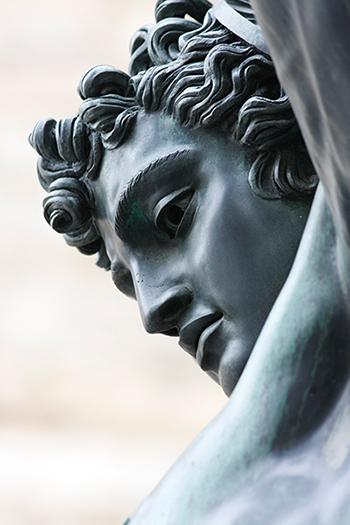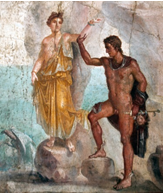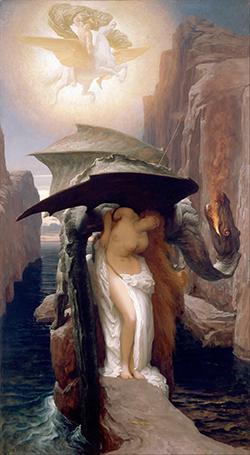 As you’re enjoying the spectacular sight of the Perseids streaking across the night skies, you might find yourself wondering how this phenomenon came by its name. Although this meteor shower actually consists of debris from the Swift-Tuttle comet, it seems to come from the direction of the constellation Perseus – and the term Perseids comes from the Greek ‘Perseides’, meaning ‘descendants of Perseus’. In keeping with many other constellations and celestial bodies, the Perseus constellation is named after a character from Greek mythology, and has been since antiquity. In the 2nd century CE in Alexandria, Egypt, Ptolemy compiled a textbook on astronomy, the so-called Almagest, which would remain highly influential for over a millennium. Still today, around half of the 88 modern constellations bear names given to them by Ptolemy.
As you’re enjoying the spectacular sight of the Perseids streaking across the night skies, you might find yourself wondering how this phenomenon came by its name. Although this meteor shower actually consists of debris from the Swift-Tuttle comet, it seems to come from the direction of the constellation Perseus – and the term Perseids comes from the Greek ‘Perseides’, meaning ‘descendants of Perseus’. In keeping with many other constellations and celestial bodies, the Perseus constellation is named after a character from Greek mythology, and has been since antiquity. In the 2nd century CE in Alexandria, Egypt, Ptolemy compiled a textbook on astronomy, the so-called Almagest, which would remain highly influential for over a millennium. Still today, around half of the 88 modern constellations bear names given to them by Ptolemy.
But who or what lies behind the name Perseus? It might not seem, at first glance, to be one of the most recognisable mythological names in the modern world. Unlike an Odysseus, Achilles, or Jason, Perseus was not the hero of a great epic poem, or a tragic play – or at least, not one that has survived – and you might struggle to recall the details of any of his adventures. Yet Perseus’ story has been told and retold countless times across the centuries, and it remains an important and influential part of the canon of Greek myth. In fact, you might be more familiar with aspects of this hero than you realise because, as Daniel Ogden has described him, he is ‘a cypher action-hero’, the star of a mythological story ‘with everything to offer’, from dangerous quests and battles with monsters, to chivalry and romance (Perseus, Abingdon and New York, 2008) – all of which makes great story material. Born as the result of a union between Zeus and Danae, mother and son were abandoned at sea by her father, but rescued and taken in by a fisherman, Dictys. His brother, King Polydectes, contrived to get rid of the adult Perseus by sending him on a quest to retrieve the head of the Gorgon, Medusa. This became Perseus’ most famous exploit, closely followed by his rescue of the princess Andromeda from a sea monster.
 Fig 1
Perseus’ story was a popular one for the ancient Greeks and Romans. Although important versions of it have been lost – such as plays by each of the major Athenian tragedians, Aeschylus, Sophocles, and Euripides – we do still have lengthy narratives of his adventures in, for example, Ovid’s great mythological epic of the 1st century CE, the Metamorphoses, and many examples of Perseus in visual art. In this fresco found in a house in Pompeii, which depicts Perseus and Andromeda (Fig 1), you can see his famous attributes, including the winged sandals given to him by the gods, and the head of Medusa brandished in his hand. But it is since antiquity that Perseus has been even more enthusiastically adopted by writers, artists, and filmmakers, perhaps attracted by the archetypal heroic qualities of his story. Medusa has long been a favourite monster from classical myth, thanks to her teeming mass of snakes instead of hair, and her terrifying gaze which could turn a man to stone, even after she was decapitated. This petrifying sight was famously captured by Renaissance artists such as Caravaggio, who painted Medusa’s head on a wooden shield (1597), and sculptors including Cellini (1545), whose bronze statue of Perseus holding Medusa’s head was created for the Medici family in Florence.
Fig 1
Perseus’ story was a popular one for the ancient Greeks and Romans. Although important versions of it have been lost – such as plays by each of the major Athenian tragedians, Aeschylus, Sophocles, and Euripides – we do still have lengthy narratives of his adventures in, for example, Ovid’s great mythological epic of the 1st century CE, the Metamorphoses, and many examples of Perseus in visual art. In this fresco found in a house in Pompeii, which depicts Perseus and Andromeda (Fig 1), you can see his famous attributes, including the winged sandals given to him by the gods, and the head of Medusa brandished in his hand. But it is since antiquity that Perseus has been even more enthusiastically adopted by writers, artists, and filmmakers, perhaps attracted by the archetypal heroic qualities of his story. Medusa has long been a favourite monster from classical myth, thanks to her teeming mass of snakes instead of hair, and her terrifying gaze which could turn a man to stone, even after she was decapitated. This petrifying sight was famously captured by Renaissance artists such as Caravaggio, who painted Medusa’s head on a wooden shield (1597), and sculptors including Cellini (1545), whose bronze statue of Perseus holding Medusa’s head was created for the Medici family in Florence.
 Fig 2
By contrast, more recent versions of Medusa have attempted to give her a more human spin: in Carol Ann Duffy’s ‘Medusa’ poem, for example (part of The World’s Wife collection (1999)), the myth is used as a metaphor for a jealous woman who’s been betrayed by her lover. The romantic aspects of other parts of Perseus’ story have also been attractive to writers and artists, especially his gallant defeat of the sea-monster that threatened the beautiful Andromeda. The Pre-Raphaelites were particular fans of this episode, which lent itself so well to their fascination with a distant and chivalric past, and with a kind of noble spirituality and beauty. Frederic, Lord Leighton painted a Perseus and Andromeda in 1891 (Fig 2), while Edward Burne-Jones included the scene in a series of 10 paintings on the Perseus myth, commissioned by Lord Arthur Balfour in 1875.
Fig 2
By contrast, more recent versions of Medusa have attempted to give her a more human spin: in Carol Ann Duffy’s ‘Medusa’ poem, for example (part of The World’s Wife collection (1999)), the myth is used as a metaphor for a jealous woman who’s been betrayed by her lover. The romantic aspects of other parts of Perseus’ story have also been attractive to writers and artists, especially his gallant defeat of the sea-monster that threatened the beautiful Andromeda. The Pre-Raphaelites were particular fans of this episode, which lent itself so well to their fascination with a distant and chivalric past, and with a kind of noble spirituality and beauty. Frederic, Lord Leighton painted a Perseus and Andromeda in 1891 (Fig 2), while Edward Burne-Jones included the scene in a series of 10 paintings on the Perseus myth, commissioned by Lord Arthur Balfour in 1875.
Over the past few decades, though, it is cinema which has done most to keep Perseus centre-stage, notably in the two Clash of the Titans films (1981 and 2010, along with the 2012 sequel, Wrath of the Titans). Each film follows the rough outline of Perseus’ story known from the ancient sources, but with some interesting twists and additions: the sea-monster has become the terrifying Kraken, which in fact comes from Norse mythology, while the 2010 film also introduces characters such as the Djinn, from the Arabic tradition. Other recent versions of Perseus have taken a similar ‘pick and mix’ approach to his myths. Percy Jackson, the hero of Rick Riordan’s series of children’s books (the first two of which have also been adapted for cinema) is named after Perseus, and in the first book, Percy Jackson and the Lightning Thief, he encounters some of the same episodes, such as an encounter with Medusa. In another story, The Sea of Monsters, Percy’s mortal mother tells him that she named him after Perseus because ‘the original Perseus was one of the only heroes in the Greek myths who got a happy ending’. This is a useful pointer towards understanding why it is that Perseus today is something of an unfamiliar hero, and yet one whose story keeps on being told and adapted. His story is uncomplicated yet satisfying, and he doesn’t force us to think about any of the difficult aspects of heroic behaviour that regularly crop up in other myths – such as Achilles’ terrible anger, Oedipus’ incest, or Odysseus’ willingness to lie. Rather, the appeal of Perseus lies in this simple heroic narrative, a classic tale of good defeating evil.



Rate and Review
Rate this article
Review this article
Log into OpenLearn to leave reviews and join in the conversation.
Article reviews